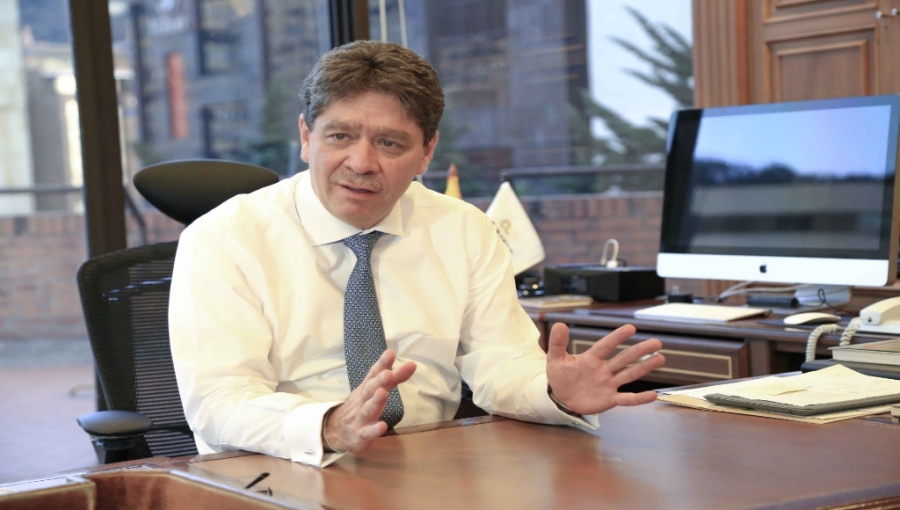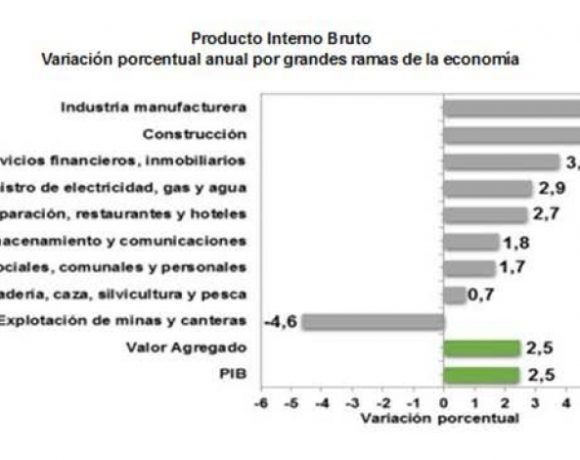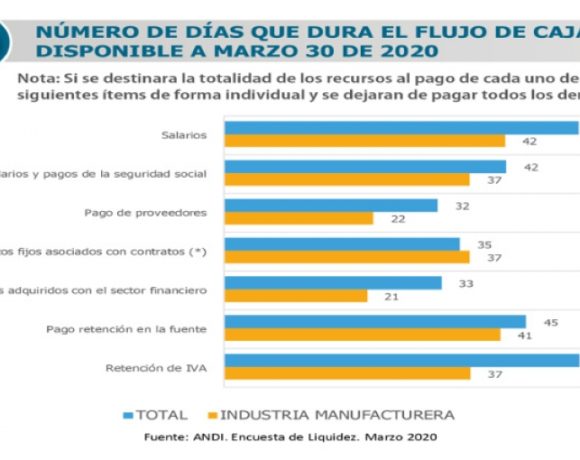Colombia’s Economy Improving, but Key Challenges Remain: Andi Annual Study

Andi — Colombia’s biggest and most influential industrial-commercial trade association, born in Medellin – on January 3 issued its latest annual economic outlook report, finding that Colombia continues to improve in several key economic competitiveness areas — but still lags in others.
“Colombia ends 2019 with a fairly acceptable performance in the economic field,” stated Andi president Bruce MacMaster.
During 2019, Colombia’s manufacturing industry showed “moderate” growth year-on-year, although slightly lower compared to 2018’s growth, the study found.
Between January and October 2019, Andi’s “Joint Industrial Opinion Survey” (“EOIC” in Spanish initials) reported an increase of 1.8% in industrial production (down from 2.9% in 2018); a 2.8% rise in total foreign plus domestic sales (down from 3.3% growth in 2019) and a 2.9% hike in sales for the national market (up from 2.6% in 2018), according to the trade group.
As for the general economic growth (“PIB” in Spanish initials), Colombia is outstripping nearly all of Latin America, rising above 3% for full-year 2019 – in contrast to 10 consecutive quarters in prior years that had growth rates below 2.5% and even in some quarters below 2%, Andi noted.
“However, 3% [annual PIB growth] rates are not enough. They are far from Colombia’s long-term [historic] growth, which is between 4% to 4.5%, and [3% annual growth] will not allow us to respond to the great challenge that the country has today to generate quality jobs and meet great needs in social and competitiveness,” according to Andi.
“Household consumption, which had grown 3.6% [year-on-year] in 2018, at the end of the third quarter of 2019 grew 4.7%. Meanwhile, investment measured by gross formation of fixed capital went from 0.8% in 2018 to 4.6% in the same period of 2019.
“This behavior of investment [growth] is explained by the confidence that national investors and foreigners have in the country and also thanks to the incentive represented by the new Financing Law that corrects a lag that we had with respect to other countries by allowing VAT [value-added tax] deduction for the purchase of capital goods.
“With all of the above, Colombia remains one of the promising economies in the region and this is perceived by the risk rating agencies that keep the country in investment grade. In the same direction, foreign direct investment (FDI) flows to the country have been maintained this past year and recorded growth of over 20%, both in FDI towards the oil sector and oriented towards other sectors.”
Meanwhile, “2020 will bring great challenges. The recovery phase that began in the last two years should be consolidated and the country should look for growths greater than 4% and even 5%.
“For this [to happen], the recently enacted tax package [dubbed ‘Economic Growth Law’] constitutes a positive investment incentive. It is also important that both the public and private sectors closely monitor the commitments of the Growth Pacts, which would also contribute to a better environment to boost the economy. No less important is a strong export strategy that allows us to penetrate new markets and diversify the export basket.
“Another great challenge is in formalization. Colombia still has high levels of labor, product and business informality. The country has already made progress in making decisions to reduce informality such as the reduction of [company formalization] procedures, a simplified taxation system and electronic invoices.
“To this is added the CONPES [the national economic planning organization] initiative for business formalization, whose main purpose is the implementation of an action plan to improve the cost-benefit ratio of a company to be formal,” Andi added.
Competitiveness: Crucial for Growth
While Andi noted that the year 2019 was generally positive, “this level of economic growth is not enough for the country to transform and achieve greater development, a better level of employment and an increase in investment.
“That is achieved with a competitiveness strategy, where policies focus on Colombia being attractive both in the region and internationally in terms of infrastructure, human capital, institutions and business development, to mention a few issues,” Andi noted.
While some major competitiveness indicators found that Colombia showed “slight improvements in the year 2019, the position that the country occupies is still lagging behind,” according to Andi.
“The World Economic Forum [WEF or ‘FEM’ in Spanish initials] placed Colombia at position 57 among 141 countries in the Global Competitiveness Index 4.0, reflecting a three-position advance over the previous year, when it was in position 60.
“The top positions [in the WEF survey] are held by Singapore, the United States and Hong Kong. Asian countries such as [South] Korea and China remain in high positions in positions, at 13 and 28 respectively. India on the other hand fell 10 positions with respect to the prior year, placing itself in position 68.
“In Latin America, Colombia is in position four among the [WEF] countries analyzed, and continues to be better placed in the ranking than Costa Rica, Peru, Panama, Brazil, Argentina, Ecuador, Paraguay and Venezuela. However, although Chile, Mexico and Uruguay did not show improvements in the global index [in 2019], these countries continued to place themselves in higher positions in the indicator.
“The rise by three positions [in the global WEF survey] by Colombia is mainly explained by significant improvements in macroeconomic stability, health and labor market.
“On the other hand, we deteriorated in institutions and in TIC [advanced technology, information and communications] adoption.
“Among the indicators of institutions, the fall in protection of intellectual property and verifications and balances is highlighted. On the other hand, the fall in TIC adoption is mainly due to the fall in Internet users.
“In infrastructure, we improved by two positions. The indicators that stand out for their progress are efficiency in train services and electricity.
“Macroeconomic stability had an advance of 13 positions, reaching 43, where inflation was the determining indicator.
“In human capital, the country advanced nine positions for the improvement in health indicators, specifically for healthy life expectancy. For its part, the skills indicator showed no progress, and we remain in an unfavorable position (80).
“In markets [efficiencies], we fell two positions due to the decline in the product market and in the financial system. The fall in the product market was due to significant deterioration in the following indicators: scope of market dominance, competition in professional services, competition in network services and complexity of tariffs.
“For its part, trade tariffs had an advance of 14 positions. In the financial system, the indicator of delinquent bank loans (as a percent of the value of the loan portfolio) was the one with the greatest decline.
“The labor market, meanwhile, had a significant improvement of seven positions, explained by the good performance of flexibility in salary determination, confidence in professional management and the meritocracy-and-incentive indicator.
“In the innovation ecosystem, Colombia lost six positions in the ranking, reaching 66. The capacity for innovation is the biggest challenge, since it fell four positions.
“The indicators that lost positions [relative ranking declines] were that of interaction and diversity, diversity of the workforce, status of cluster development and patent applications. The behavior in the indicator of collaboration within the company that improved 30 positions stands out as positive,” according to Andi.
“The pillars in which Colombia performed less favorably were that of business growth, legal certainty and internationalization.
“In legal certainty, the country’s environment is not friendly and shows that Colombia has a lot to advance in this area, since the constant change in the rules of the game is a great limitation for companies.
“Indicators such as transparency and contract compliance time show a weak performance in the country. In internationalization, the indicator that does not show good performance is that of the [transparency] environment, due to indicators such as time to import and foreign currency reserves.
“The competitive environment of the country, although it has improved, there are many challenges and a long way to go. In infrastructure, costs and environment, we occupy the least favorable positions, while in technology and education the indicators show a better position (49 and 50).
“In [business] formalization, the position occupied by Colombia was 52, due to the country’s environment in this area. The indicators of transparency and burden of government regulation are those that place the country in a less favorable position,” Andi added.
“The digital transformation in Colombia is, together with innovation and entrepreneurship, the pillar in which the country is better located, ranking 51.
“Within this pillar, the country’s performance in ‘GovTech’ stands out, due to the good performance in indicators such as the government online services index, electronic participation index and the importance of TIC for the government vision.
“In the areas of [TIC development] infrastructure, digital talent and environment, we still have a long way to move forward,” Andi concluded.
IMD Rankings
“Likewise, the IMD [the Swiss-based business-development education program often ranked top in the world] in its global competitiveness ranking published in May [2019] shows a good performance for Colombia, with an improvement of six positions, achieving position 52 among 63 countries,” according to the Andi analysis.
“Within this [IMD] indicator, most of the measurement factors had improvements, which include the labor market indicator ranking (+21), prices (+17), attitudes and values (+10), fiscal policy (+7) and technological infrastructure (+7). On the other hand, the indicators for foreign trade, foreign investment, public finances and health and environment, fell between three and five positions.
“For its part, the ‘Doing Business’ [research organization] in its report, ‘Ease of Doing Business,’ presented an unfavorable panorama for the country, with a deterioration in the general ranking of two positions, going from 65 to 67 among 190 countries,” Andi noted.
















